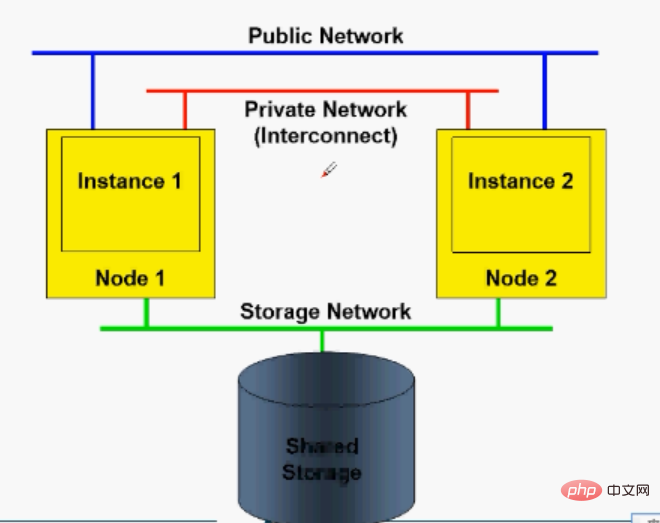what is oraclerac
oracle rac refers to Oracle Real-time Application Cluster, which is a cluster database with a shared cache architecture. It overcomes the limitations of the traditional shared nothing method and shared disk method, and provides a user-friendly solution for all business applications. A highly scalable and available database solution.

The operating environment of this tutorial: Windows 7 system, Oracle 11g version, Dell G3 computer.
What is Oracle RAC
Oracle RAC (real application clusters, "real-time application clusters") is a cluster database with a shared cache architecture , which overcomes the limitations of traditional shared-nothing and shared-disk approaches, providing a highly scalable and available database solution for all your business applications. Oracle RAC is a key component of Oracle Private Cloud architecture.
Oracle RAC can eliminate the single point of failure problem of the database server, thereby providing customers with excellent database availability. In a clustered server environment, the database itself is shared across the server pool, which means that if any server in the pool fails, the database will continue to run on the healthy server. Oracle RAC not only allows customers to continue handling database workloads in the event of a server failure, but it also helps reduce downtime costs by reducing planned offline maintenance of the database.
Oracle RAC supports transparent deployment of Oracle databases on clustered server pools. This allows customers to easily redeploy Oracle Database on a single server to a cluster of database servers, taking advantage of the consolidated memory capacity and processing power provided by clustered database servers.
Oracle RAC provides all the necessary software components to allow you to easily deploy Oracle Database on a server pool and take full advantage of the performance, scalability and availability provided by the cluster. Oracle RAC leverages Oracle Grid Infrastructure as the foundation for the Oracle RAC database system. Oracle Grid Infrastructure includes Oracle Clusterware and Oracle Automatic Storage Management (ASM) to efficiently share server and storage resources in a highly available and scalable database cloud environment.
Advantages:
Oracle RAC mainly supports Oracle9i, 10g, 11g, and 12C versions, and can support 24 x 7 effective database application systems. Build a high-availability database system on low-cost servers and deploy applications freely without modifying the code.
In the Oracle RAC environment, Oracle integration provides cluster software and storage management software, reducing application costs for users. When the application scale needs to be expanded, users can expand the system as needed to ensure system performance.
(1) Multi-node load balancing;
(2) Provide high availability: fault tolerance and seamless switching functions to minimize the impact of hardware and software errors;
(3) Improve transaction response time through parallel execution technology--usually used for data analysis systems;
(4) Increase the number of transactions and connections per second through horizontal expansion--usually for Online transaction system;
(5) Save hardware costs, you can use multiple cheap PC servers to replace expensive minicomputers or mainframes, while saving corresponding maintenance costs;
(6) Expandable It has good performance and can easily add and delete nodes and expand hardware resources.
Disadvantages:
(1) Compared with a single machine, the management is more complex and the requirements are higher;
(2) When the system planning and design is poor, the performance may not even be as good as a single node;
(3) It may increase the software cost (if you use a high-configuration PC server, Oracle generally charges based on the number of CPUs).
Before Oracle9i, the name of RAC was OPS (Oracle parallel Server). A big difference between RAC and OPS is that RAC uses Cache Fusion (cache merging) technology. In OPS, data requests between nodes require the data to be written to disk before the requesting node can read the data. When using Cache fusion, the data buffers of each RAC node transmit data blocks through the high-speed, low-latency internal network.
What problem does rac solve
1. High availability: automatic switching, load balancing
2. High performance: multiple instances, more connections, concurrent execution
3. High expansion: expand nodes without downtime.
RAC architecture

Recommended tutorial: "Oracle Tutorial"
The above is the detailed content of what is oraclerac. For more information, please follow other related articles on the PHP Chinese website!

Hot AI Tools

Undresser.AI Undress
AI-powered app for creating realistic nude photos

AI Clothes Remover
Online AI tool for removing clothes from photos.

Undress AI Tool
Undress images for free

Clothoff.io
AI clothes remover

Video Face Swap
Swap faces in any video effortlessly with our completely free AI face swap tool!

Hot Article

Hot Tools

Notepad++7.3.1
Easy-to-use and free code editor

SublimeText3 Chinese version
Chinese version, very easy to use

Zend Studio 13.0.1
Powerful PHP integrated development environment

Dreamweaver CS6
Visual web development tools

SublimeText3 Mac version
God-level code editing software (SublimeText3)

Hot Topics
 1676
1676
 14
14
 1429
1429
 52
52
 1333
1333
 25
25
 1278
1278
 29
29
 1257
1257
 24
24
 What to do if the oracle can't be opened
Apr 11, 2025 pm 10:06 PM
What to do if the oracle can't be opened
Apr 11, 2025 pm 10:06 PM
Solutions to Oracle cannot be opened include: 1. Start the database service; 2. Start the listener; 3. Check port conflicts; 4. Set environment variables correctly; 5. Make sure the firewall or antivirus software does not block the connection; 6. Check whether the server is closed; 7. Use RMAN to recover corrupt files; 8. Check whether the TNS service name is correct; 9. Check network connection; 10. Reinstall Oracle software.
 How to solve the problem of closing oracle cursor
Apr 11, 2025 pm 10:18 PM
How to solve the problem of closing oracle cursor
Apr 11, 2025 pm 10:18 PM
The method to solve the Oracle cursor closure problem includes: explicitly closing the cursor using the CLOSE statement. Declare the cursor in the FOR UPDATE clause so that it automatically closes after the scope is ended. Declare the cursor in the USING clause so that it automatically closes when the associated PL/SQL variable is closed. Use exception handling to ensure that the cursor is closed in any exception situation. Use the connection pool to automatically close the cursor. Disable automatic submission and delay cursor closing.
 How to create cursors in oracle loop
Apr 12, 2025 am 06:18 AM
How to create cursors in oracle loop
Apr 12, 2025 am 06:18 AM
In Oracle, the FOR LOOP loop can create cursors dynamically. The steps are: 1. Define the cursor type; 2. Create the loop; 3. Create the cursor dynamically; 4. Execute the cursor; 5. Close the cursor. Example: A cursor can be created cycle-by-circuit to display the names and salaries of the top 10 employees.
 How to export oracle view
Apr 12, 2025 am 06:15 AM
How to export oracle view
Apr 12, 2025 am 06:15 AM
Oracle views can be exported through the EXP utility: Log in to the Oracle database. Start the EXP utility, specifying the view name and export directory. Enter export parameters, including target mode, file format, and tablespace. Start exporting. Verify the export using the impdp utility.
 What to do if the oracle log is full
Apr 12, 2025 am 06:09 AM
What to do if the oracle log is full
Apr 12, 2025 am 06:09 AM
When Oracle log files are full, the following solutions can be adopted: 1) Clean old log files; 2) Increase the log file size; 3) Increase the log file group; 4) Set up automatic log management; 5) Reinitialize the database. Before implementing any solution, it is recommended to back up the database to prevent data loss.
 Oracle's Role in the Business World
Apr 23, 2025 am 12:01 AM
Oracle's Role in the Business World
Apr 23, 2025 am 12:01 AM
Oracle is not only a database company, but also a leader in cloud computing and ERP systems. 1. Oracle provides comprehensive solutions from database to cloud services and ERP systems. 2. OracleCloud challenges AWS and Azure, providing IaaS, PaaS and SaaS services. 3. Oracle's ERP systems such as E-BusinessSuite and FusionApplications help enterprises optimize operations.
 What steps are required to configure CentOS in HDFS
Apr 14, 2025 pm 06:42 PM
What steps are required to configure CentOS in HDFS
Apr 14, 2025 pm 06:42 PM
Building a Hadoop Distributed File System (HDFS) on a CentOS system requires multiple steps. This article provides a brief configuration guide. 1. Prepare to install JDK in the early stage: Install JavaDevelopmentKit (JDK) on all nodes, and the version must be compatible with Hadoop. The installation package can be downloaded from the Oracle official website. Environment variable configuration: Edit /etc/profile file, set Java and Hadoop environment variables, so that the system can find the installation path of JDK and Hadoop. 2. Security configuration: SSH password-free login to generate SSH key: Use the ssh-keygen command on each node
 How to stop oracle database
Apr 12, 2025 am 06:12 AM
How to stop oracle database
Apr 12, 2025 am 06:12 AM
To stop an Oracle database, perform the following steps: 1. Connect to the database; 2. Shutdown immediately; 3. Shutdown abort completely.




